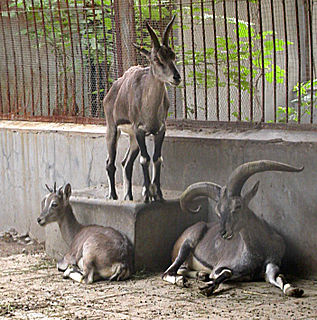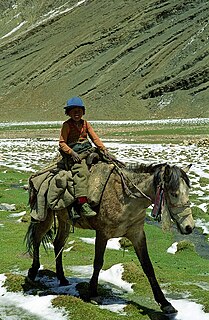 W
WPseudois is a genus in the subfamily Caprinae comprising two species, the bharal and the dwarf blue sheep. Both species in the genus are variously known as blue sheep, the bharal's alternate name being the Himalayan blue sheep.
 W
WThe Tibetan antelope or chiru is a medium-sized bovid native to the Tibetan plateau. Fewer than 150,000 mature individuals are left in the wild, but the population is currently thought to be increasing. In 1980s and 1990s, they had become endangered due to massive illegal poaching. They are hunted for their extremely soft, light and warm underfur which is usually obtained after death. This underfur, known as shahtoosh, is used to weave luxury shawls. Shahtoosh shawls were traditionally given as wedding gifts in India and it takes the underfur of three to five adult antelopes to make one shawl. Despite strict controls on trade of shahtoosh products and CITES listing, there is still demand for these luxury items. Within India, shawls are worth $1,000-$5,000, internationally the price can reach as high as $20,000.
 W
WThe Tibetan bear or Tibetan blue bear is a subspecies of the brown bear found in the eastern Tibetan Plateau. It is also known as the Himalayan blue bear, Himalayan snow bear, Tibetan brown bear, or the horse bear. In Tibetan, it is known as Dom gyamuk.
 W
WThe Tibetan red deer also known as shou, is a subspecies of elk (wapiti) native to the southern Tibetan highlands and Bhutan. Once believed to be near-extinct, its population has increased to over 8,300, the majority of which live in a 120,000-hectare nature reserve established in 1993 in Riwoqê County, Qamdo Prefecture, Tibet Autonomous Region, China. Some have been kept at the beginning of the 20th century in London, and in a small zoo south of Lhasa.
 W
WThe Tibetan fox, also known as Tibetan sand fox, is a species of true fox endemic to the high Tibetan Plateau, Ladakh plateau, Nepal, China, Sikkim, and Bhutan, up to altitudes of about 5,300 m (17,400 ft). It is listed as Least Concern in the IUCN Red List, on account of its widespread range in the Tibetan Plateau's steppes and semi-deserts.
 W
WThe Himalayan marmot is a marmot species that inhabits alpine grasslands throughout the Himalayas and on the Tibetan Plateau. It is IUCN Red Listed as Least Concern because of its wide range and possibly large population.
 W
WThe kiang is the largest of the Asinus subgenus. It is native to the Tibetan Plateau, where it inhabits montane and alpine grasslands. Its current range is restricted to plains of the Tibetan plateau and Ladakh, India, and northern Nepal along the Tibetan border. Other common names for this species include Tibetan wild ass, khyang and gorkhar. Travellers' accounts of the kiang are one inspiration for the unicorn.
 W
WThe Ladak pika, also known as the Ladakh pika, is a species of mammal in the family Ochotonidae found in China, India, and Pakistan. Prior to identification as a separate species, specimens were thought to be of the plateau pika. Named for the Ladakh region, they are commonly found in valleys of the mountain ranges spanning from Pakistan through India to China at an elevation between 4,300 and 5,450 m and are herbivores.
 W
WThe snow leopard, also known as the ounce, is a large cat native to the mountain ranges of Central and South Asia. It is listed as Vulnerable on the IUCN Red List because the global population is estimated to number less than 10,000 mature individuals and is expected to decline about 10% by 2040. It is threatened by poaching and habitat destruction following infrastructural developments. It inhabits alpine and subalpine zones at elevations from 3,000 to 4,500 m, ranging from eastern Afghanistan, the Himalayas and the Tibetan Plateau, to southern Siberia, Mongolia, and western China. In the countries in the northern part of its range, it also lives at lower elevations.
 W
WThe Nubra pika is a species of mammal of the pika family, Ochotonidae. It is found in Bhutan, China, India, Nepal, and Pakistan.
 W
WThe Tibetan pony is today found in Tibet. Once thought to be simple hardy mountain ponies developed from Mongolian stock, recent research indicates that there may be up to six separate horse breeds native to Tibet.
 W
WThe domestic yak is a long-haired domesticated cattle found throughout the Himalayan region of the Indian subcontinent, the Tibetan Plateau, Northern Myanmar, Yunnan, Sichuan and as far north as Mongolia and Siberia. It is descended from the wild yak.